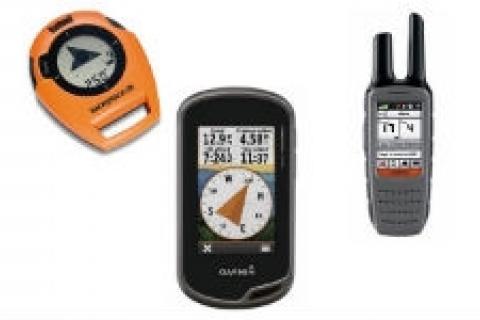
Handheld GPS units are a great all-in-one tool — map, compass, and navigating record keeper — for day hikers and back country backpackers alike. With the wide selection of handheld GPS units available, choosing one that fits your navigational needs and budget can be confusing. Consider the following points to easily find your way to buying the best GPS unit for your needs.
 |
| Keeping on track is easily accomplished with guidance from a handheld GPS unit. |
How Does GPS Work?
The heart of the GPS is the satellites orbiting the earth. The satellites are supplied with atomic clocks that emit signals of their location and time. These signals are received by a GPS unit. Once the GPS locks onto four or more satellites, the unit determines its location on earth and displays the results on a small LCD screen. Accuracy of that reading depends on the number of satellites the GPS Unit is locked onto, with more being better.
GPS Units Com in All Shapes and Sizes
Many cell phone models also come with navigational abilities, but most use cell phone towers to pinpoint location. As long as the cell phone has tower strength, the GPS elements work, but if not, the phone is useless as a navigation device.
The simple pocket watch-sized units are capable of recording your starting point, a couple points along the way, and back to the starting point. These little GPS units are primarily used for tracing your steps back to camp with only a couple buttons to push. Some models in this class also display time, altitude, temperature, and elevation. Similar units are now built to fit on the wrist in a GPS watch format. These basic models sell for about $100.
The most common models include cell phone-sized units. Although these are similar in size to a cell phone, that’s where the similarities end. The unit fits in the hand nicely and even with a few extra buttons, it’s easy to operate with a bit of practice. The screen displays a map with details either built-in or added by the user and is easily read while on the move. Screens sizes have grown to allow more map details to be viewed at one time.
| GPS units can also be found in two-way radios. |
A workhorse of this class is the Garmin Monterra, selling for $699. The Monterra uses a touchscreen to make command selection easier than trying to remember which hard buttons do what on units without touchscreens. For this higher price, the user also gets more goodies such as a camera that shoots stills and video. The DeLorme inReach SE Satellite Communicator sends and receives text messages with GPS coordinates. This unit, which sells for $299, also accepts topo maps and NOAA charts through a simple download.
The third group of the handheld GPS family is the talker in the clan. Two-way radios are merged with GPS units to create the best opportunity for staying on your way and keeping in contact with your comrades who are along for the adventure. The starting model in the group includes just that: a two-way radio and a GPS unit with a built-in map. The unit at the top of this group sports a barometer, altimeter, NOAA weather radio, color touchscreen, and a long-lasting battery pack to power it all.
Battery Life and Memory Capabilities
Battery life varies per unit and the more features a unit has, the more energy it takes to run them. On average, handheld GPS units will stay powered for 12 hours on two AA batteries or a lithium-ion battery pack in higher end models. Depending on the length of travel the GPS will be tracking on your excursion, a set of batteries will last a weekend if the unit is turned off while not moving.
| Handheld GPS units come with minimal options to all the bells and whistles, like this one from Garmin. |
The GPS unit’s memory is as important as its ability to capture a satellite’s signal. Memory comes in two ways: internal and via removable memory card. Internal memory will suffice if the built-in map works for your application. If 24 MB of internal memory is capable of holding the map you desire, then go that route. But if you plan or even if the possibility may arise in the future to add more map details, then select the unit with expandable memory capability.
No matter what handheld GPS unit you select, plan on practicing with it in the backyard, around town, and while visiting friends in the next county or state. Once you get the feel of the buttons or touch screen, you’ll be on your way to enjoying and exploring the outdoors like you’ve never done before – and find your way back home.
![]() If you’re in the market for a GPS unit, check out this product review "Hunting Premium Maps for Garmin GPS Units" for more information
If you’re in the market for a GPS unit, check out this product review "Hunting Premium Maps for Garmin GPS Units" for more information
- 10768 views

